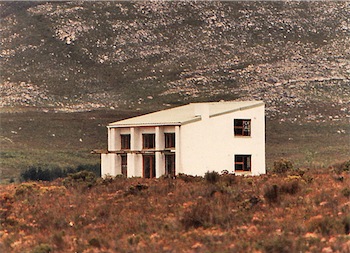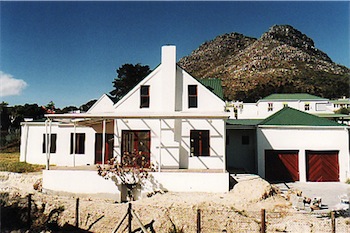Some Good Reasons to Owner Build
 The Pros and Cons of Owner Building: A personal review
The Pros and Cons of Owner Building: A personal review
After updating our ever-popular title, The Complete Book of Owner Building in South Africa (published in 2012 – see book cover, left-bottom right), we were left wondering whether owner building really is a good idea or not.
We’ve completed the owner building exercise three times, and not once made any money, or in fact even got our money back on any of the projects. So why would it be a good idea for you?
Perhaps you see the owner building exercise as a challenge. Or maybe it is an opportunity for you to prove you can do it better than we did. Maybe you’d decide to owner build just because you can! After all if you get it right (and let’s be fair, many people do), you could save yourself a lot of money and end up with your dream house.
Now if you’re wondering why this would persuade you to buy the new version of the book (published and distributed by Random House Struik), the one thing these building exercises did teach us was what not to do! With this knowledge, we have put together a title that will hopefully help you achieve your dreams. We have also discussed every aspect of construction in relation to South Africa’s National Building Regulations. And there are lots of good ideas and beautiful photographs of other people’s construction projects as well as a bundle of finished homes and gardens.
Our First Owner Building Challenge
One’s first experience of anything is always special in one way or another. We had managed to buy two tiny seaside plots with a small (minuscule in fact) inheritance, and decided to build on one and then sell it to be able to build something on the second – for ourselves, rather than for resale. The first project, we thought, would pay for the second.
The idea is a good one, but firstly you need sufficient money to achieve Plan 1; and then you need to be sure that you will make money on it within your time frame. In reality, even many full-time property developers have to wait a while before they make money on developments. And they usually have multiple units to sell, so they make money back progressively, over time.
We had a minimal budget. We spent more than our budget. So the inevitable happened, we needed to sell quickly.
A downturn in the property market hit us hard, especially since this building venture was in a relatively remote spot that was, at best, an up-and-coming holiday spot. The fact that 10 years down the line the area began to blossom, was irrelevant in the scale of things. It was too late.

The house was basic, but sweet. We couldn’t afford decorative finishes, or even basic appliances (like a fridge and stove), so that we could at least make use of it – or rent it out and recoup some money. When did spend a few weekends there, sleeping on mattresses on the floor, and using a cooler box to keep food and drink cool.
The sad reality was that we had to sell, and were becoming increasingly desperate. After an unsuccessful auction, a qualified professional in the building industry bought the property for a song.
This meant that we didn’t get enough out of the project to build on the second plot, and eventually lost that too… on a forced auction.
Going… going… GONE!
Our Second Owner Building Challenge
This time we did it correctly, or so we thought. Certainly it was as right as we could have done it, but because we were owner-building, the buck stopped with us. We had nobody else to blame for errors, even if we didn’t make them ourselves.
We bought the plot, secured the finance to build using a solid quantification and costing programme, and then got down to work.
So what went wrong?
Two major factors worked against us
- The so-called professional who helped to survey the site didn’t pick up that we were building on a slope. The property looked flat enough, and we weren’t advised to formally assess the slope.
- Nobody realised that our neighbour’s soakaway drained way into our property, until after our foundations had been dug – not even the municipal health inspector.
That was enough to destroy a half decent budget. Not only was the slope considerably more substantial than everybody seemed to think, but we had to move the entire build forward to avoid the health hazard of the illegal soakaway (or French drain) behind us. It didn’t occur to us that we might have a claim against our neighbour.
So we went ahead and built the house which, I have to admit, while spacious and full of architectural features (for example, we only used doors and windows scavenged from demolition sites) had a few other follies. The most expensive of these was a long – admittedly very handsome – passage leading from a glorious front door we had rescued from some huge wonderful building we never knew.

The slope also cost us, because the foundation wall at the back of the house ended up over 2 m (or 6½ ft) high. Then there was the fill which had to be transported to site to fill the void.
Apart from the obvious additional costs, the major impact of the follies and mistakes (be they ours or other people’s) was that we weren’t able to finish the build according to schedule. We didn’t particularly care, but the bank insisted we finish. Bank managers visited the site and introduced their own tough tactics.
NOW HERE IS A BIG LESSON YOU CAN LEARN FROM
When you owner-build you will negotiate draws with your bank. If they release 100% and you haven’t finished the house, you have a problem. This is what happened to us, and the bully-bank (totally within their legal rights) forced us to take another loan to finish ceilings and other things that we believed we could temporarily live without – including the lounge floor. The house was huge and large enough to temporarily board up the lounge. But the bank wanted everything complete, IMMEDIATELY, if not sooner.
Could we have said no? In retrospect probably yes. But they forced us to take a personal loan that we couldn’t afford to repay. Certainly today the relatively new Consumer Protection Act would have precluded them from doing this.
So we did put in some ceilings, including a glorious kitchen ceiling that incorporated a steel pressed section from a Victorian building that had been demolished in Claremont (Cape Town). Eventually the house was sold … and then sold again … I’m not sure how many times. Some years ago, when the house was on the market and there was an open-day show house, we discovered that a later owner had carefully removed the fill, and created an extraordinary double-storey home.
We wished we’d been able to buy it back again.
Our Third Owner Building Challenge
Now we knew it all! What could possibly go wrong?
In an endeavour to avoid potential problems, we employed an architectural designer to draw the plans, and a full-time builder to do the build. What we had “forgotten” was that the builder – at that stage also a friend – was the so-called professional whose advice led us to believe we had previously been building on a virtually “flat” plot. So retrospectively, we had only ourselves to blame.
But if the NHBRC had been in existence at that time, we would have been saved a great deal of heartache. Since we had to raise a bond to build, the contractor would have not have been acceptable to the bank unless he was a paid-up member of the NHBRC.
So what did go wrong?

In a nutshell, we were ripped off by a bogus builder. Sure this is what he did full time, but his reputation was so bad that when we later tried to sell the house, property agents wouldn’t touch it with a barge pole.
In the interim we’d had to call in a consultant to arbitrate (at considerable expense), because the workmanship was so bad. For example:
- The wall on one side of the house was a brick course higher than the other, so the roof wasn’t quite level.
- The walls inside the house that should have been bagged with plaster had been vaguely and very unevenly smeared with a very weak sand-cement mix. When we complained – numerous times – the builder set to work with a box of Polyfilla, in an attempt to even the surface. It was an horrific “joke”.
- Nails had been left protruding from exposed beams.
- The brick-paved driveway was lifting and falling to pieces.
- Worst of all, he had run out of money and wasn’t able to complete the build.
NOTE: He had run out of OUR money
Eventually we did sell, and were able to repay the bond to the bank. But that was the end of it.
So would we ever owner-build again? And if we did, how would we do it differently?
We might, but only if we had the money to pay good sub-contractors and proven artisans that we could really trust to do a good job. And we would be sure to take every bit of our own advice given in The Complete Book of Owner Building seriously!
But for now we’re content to rent.
 SANS10400-Building Regulations South Africa SANS10400 are the Building regulations in South Africa, and both international and national standards, are fundamental to successful building and construction projects, both big and small.
SANS10400-Building Regulations South Africa SANS10400 are the Building regulations in South Africa, and both international and national standards, are fundamental to successful building and construction projects, both big and small.

Thank you for your honest retelling of your experiences. I’m afraid to say though that this really doesn’t encourage me to build my own home (if the experts struggle to get it right) and it also discourages me from buying your book (if they struggle to get it right, are they actually experts?).
I have recently borrowed a copy of the first edition of your book, and I have to say that I now look at it with jaded eyes.
I really do appreciate your honesty, but maybe this article should be more thoughtfully worded.
Actually Roy we did the book AFTER we had our experiences. Call it part of the University of Life. We were total novices when we plunged in the first time. It’s called a learning curve. Certainly not a case of “experts” getting it wrong!
Since then we have continued to learn more and more. Also, a lot has changed since our last building adventure which was prior to the establishment of the NHBRC and the “new” building regulations. If we knew then what we know now a lot of heartache would have been avoided.
As far as looking at the first edition of our book with jaded eyes … it is totally out of date – that is why we redid it (2012).
What we strive to do is help people who want to build their own homes get it right. Now if I had had a copy of our most recent OWner Building in South Africa, I’d have been a happy person! 🙂
Hi Penny
Can you please assist with my query? I want to build a standard double story house using clay stock bricks. The hardware next to my place only sells 7mpa bricks not 10mpa. Can I use 7mpa bricks (2 rows) for this type of structure?
Thanks
Hi Pacman,
Yes you will be fine with those. Corobrick class those as NFP – Non Facing Plastered Clay bricks that are suitable for general building work which must be plastered or rendered. With a nominal 7 MPa compressive strength. The 14 MPa called NFX – Non Facing Extra
Bricks suitable for use, plastered or unplastered for general building work below damp proof course or under damp conditions or below ground level where durability rather than aesthetics is the criteria for selection. And it goes without saying that they have to be well laid with the correct mortar mix and finished with a good plaster.
Hi Penny
I find your experiences exciting and scary at the same time. First of all, Is your book still available, I would like to buy it if I can afford it. I have been saving up and I am just about ready to build a house in the woods.. I can’t afford the City life anymore, everything is expensive and it is time to scale down. I want to build a 64.8m2 (- 10m2 Stoep), Nutec and Timber cabin with loft and I am really looking forward to DIY the hell out of my home. I don’t have much money, R200k to be precise, do you think that it will be enough? I have an idea how much the Frame, outer walls, etc. will cost me. But I don’t know if it will be enough. With your experience, can it be possible? Please guide me?
Virgel my book is still available – but get the most recent version – Owner Building in South Africa (not The Complete Book of). It has red writing on the cover and a sweet timber-frame house with red trim. I honestly can’t even guess what your house will cost to build. There are companies that specialize in Nutec homes and they would probably be able to give you an idea. You are going to need a competent person to help you with plans (at very least a draughtsperson), so that might be a good starting point for advice. Good luck.
Hi Penny
Thank you so much for responding.
I do have a draughtsman, he charges R50 per square meter. It is a decent price. I know the costs of the Water, Electricity and sewerage connection, but I have no idea what I may pay for everything else like municipal costs for the plan, permits for plumbing etc. I have no idea what else I must pay the government.
Contact the local authority and ask.